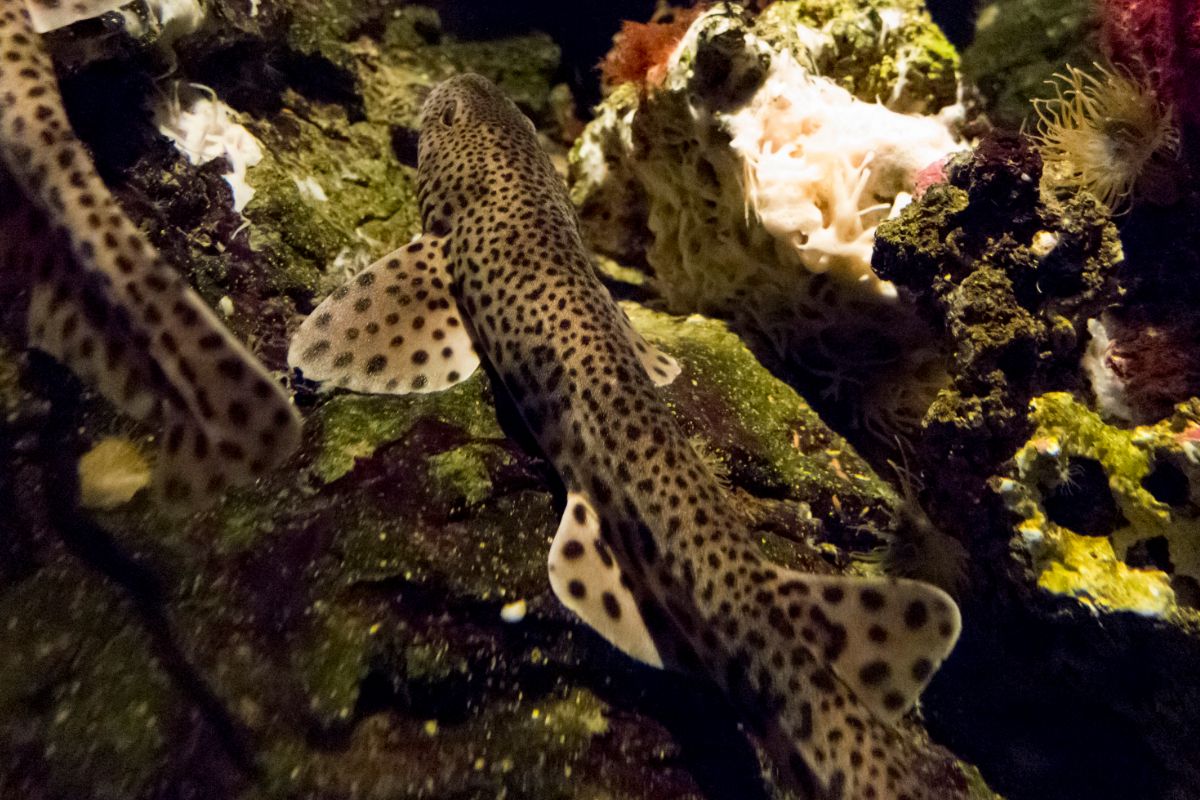When you think of sharks, probably huge Great White Sharks are the first thing that come to mind.
But sharks actually come in all shapes and sizes, and due to their diminutive size tiny shark species often get overlooked.

Unlike Great Whites, there is nothing to be afraid of with these little guys as the smallest ones can fit in your palm.
If you would like to learn more about small shark species, read on to discover all about these miniature predators!
African Lanternshark
African Lanternsharks are around 9.4 inches in length and as the name suggests, are found off the African coast.
However, you can find these little guys 1,000 to 3,300 feet below the surface of the continental shelf in West Africa.
African Lanternsharks tend to live nearly all their lives in total darkness, and catch their prey and ward off other predators with unique luminescence.
However, like most deep-sea creatures, the African Lanternshark is rather difficult to study, although we know their diets consist of crustaceans, cephalopods, and bony fish.
Despite being bottom-dwelling sharks, African Lanternsharks often find themselves caught in commercial shrimping nets.
Atlantic Ghost Catshark
Another deep-sea dwelling shark, the Atlantic Ghost Catshark is found in the Atlantic Ocean as their name suggests, mainly around the British Isles.
They tend to grow around 9.25 inches long. They love the deep, dark sea and it’s very rare to see them in fewer than 4,900 feet of water.
How do you know if you’ve encountered an Atlantic Ghost Catshark? Well, you should check their dorsal fins.
The first dorsal fin isn’t as big as their second dorsal fin.
They also have elongated eyes that take up around 5% of their bodies, and are rather cat-like. Hence their name!
The Atlantic Ghost Catshark is incredibly rare and mysterious, and little is known about their behavior and their breeding habits.
Still, it is believed that their diet consists of small bony fish like teleosts, and also cephalopods and crustaceans.
Dwarf Lanternshark
The Dwarf Lanternshark is the smallest shark in the world, according to the Guinness Book of World Records!
Male Dwarf Lanternsharks tend to grow around 6.3 inches in length, and females grow up to 7.4 inches once they reach sexual maturity.
Like most Lanternsharks, the Dwarf Lanternshark is bioluminescent to hunt prey and ward off predators.
What makes Dwarf Lanternsharks unique is that rather than lay eggs, they give birth to live pups, and their litters will consist of 2 to 3 pups.
They have a rather small habitat range and can normally be found in Columbia and Venezuela.
Just like any other small species of sharks, Dwarf Lanternsharks often end up becoming products of bycatch whilst fishing.
However, as Dwarf Lanternsharks are able to live at about 2,000 feet they can evade commercial fishing nets by swimming to these depths.
Green Lanternshark
The Green Lanternshark is a really tiny shark, with the largest one ever found measuring just 10.2 inches long.
They are found mainly in the Atlantic Ocean, the Caribbean Sea, and the Gulf of Mexico.
Male Green Lanternsharks are usually smaller than the females at around seven inches, and the females tend to grow to nine inches.
Although they’re small, Green Lanternsharks are pretty formidable in a group, and in large groups they can take down much larger animals like squid and octopus.
They are also bioluminescent, which is caused by melatonin in their cells. These cells camouflage the Green Lanternshark from any predators.
You can usually find them in deepwater from 1,200 to 3,000 feet.
Panama Ghost Catshark

The Panama Ghost Catshark is quite similar to the Atlantic Ghost Catshark.
As the name would suggest, the Panama Ghost Catshark lives solely in the Panama coast, and never grows larger than nine inches.
They are also bottom-dwelling sharks that are found in water 3,000 to 3,200 feet deep.
They are also nocturnal, meaning they sleep during the day and hunt during the night.
Another thing that makes this shark unique is that when it lays eggs they contain its young. But like most small sharks, it is very hard to study this species.
Due to insufficient data, we still don’t know much about their young and how big they are.
Pygmy Ribbontail Catshark
Usually found in the shallow depths of the Indian Ocean and the Indo-Pacific region, the Pygmy Ribbontail Catshark is found in the continental slope at 230 and 2,500 feet.
The Pygmy Ribbontail Catshark often ends up being a bycatch product by fishermen trawling for shrimp in India and other Southeast Asian countries.
However, Pygmy Ribbontail Catsharks can avoid getting stuck in fishermen nets by heading deep below the surface of the water.
Still, Pygmy Ribbontail Catsharks that live in Yemen off the Gulf of Aden can avoid being caught as a byproduct as there are no commercial fisheries operating here.
Many male Pygmy Ribbontail Catsharks grow up to just 7.4 inches in length, and the females grow up to just 6.3 inches in length.
Although the biggest Pygmy Ribbontail Catshark was around 9 inches long.
Smalleye Pygmy Shark
Growing to just 8.7 inches long, the Smalleye Pygmy Shark is slightly smaller than some other small sharks in our article.
You can find these sharks in the Pacific Ocean at pretty much every water level.
But these sharks do avoid the abyssopelagic zone and can be found at different water depths depending on the time of day.
In the evening hours, the Smalleye Pygmy Shark can be found in the higher ocean layers to hunt, but earlier in the day it will reside in deeper waters.
In just one day, this little guy can travel 6,500 feet below the surface to around 500 feet below the surface – no mean feat!
The Smalleye Pygmy Shark resides mainly on continental slopes which explains why it can cover some pretty aggressive ground.
You can mainly find the Smalleye Pygmy Shark in Australia, Indonesia, Japan, and Taiwan.
Their population is still pretty high, so we don’t have to worry about this species being endangered in the near future.
Spined Pygmy Shark
The Spined Pygmy Shark has arguably the strongest numbers of any small shark in our article.
Their population is quite spread out throughout the world in many different islands and continents.
You can find Spined Pygmy Sharks in the Atlantic Ocean, Pacific Ocean, and the Indian Ocean!
The Spined Pygmy Shark lives in depths of 2,000 and 2,500 feet below the surface of the ocean, although it can live as low as 5,900 feet too.
They are also another shark that gives birth to live pups, with litters consisting of 3-5 pups. These pups are usually around 3 inches long.
Meanwhile, male Spined Pygmy Sharks can grow to about 5.9 inches long, and female Spined Pygmy Sharks can be just over 6.9-7.7 inches long.
Interestingly, the Spined Pygmy Shark was once believed to be the smallest shark in the world.
Final Thoughts
So there you have it! Eight of the smallest shark species in the world!
While these sharks are totally harmless towards humans, as they are so small it is very difficult for scientists to study them.
But we hope that as technology advances we can further explore more of the ocean depths and learn more about these incredible creatures!
- Is It Possible For A Shark To Swim Backwards? - August 2, 2022
- Are Leopard Sharks Dangerous? - August 2, 2022
- What Are The Differences Between Shark And Dolphin Fins? - August 1, 2022








